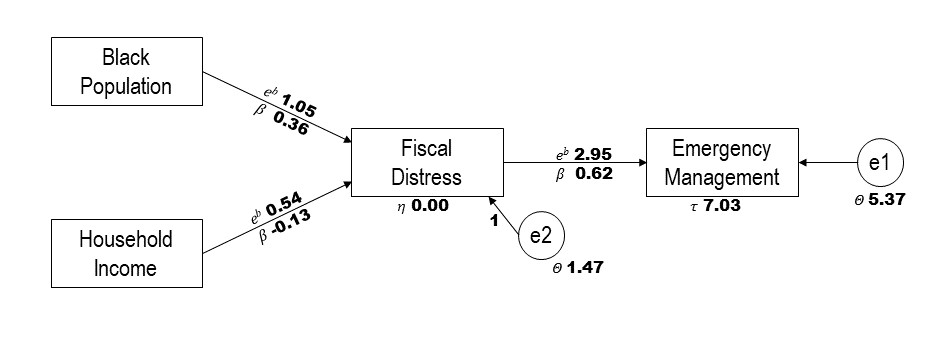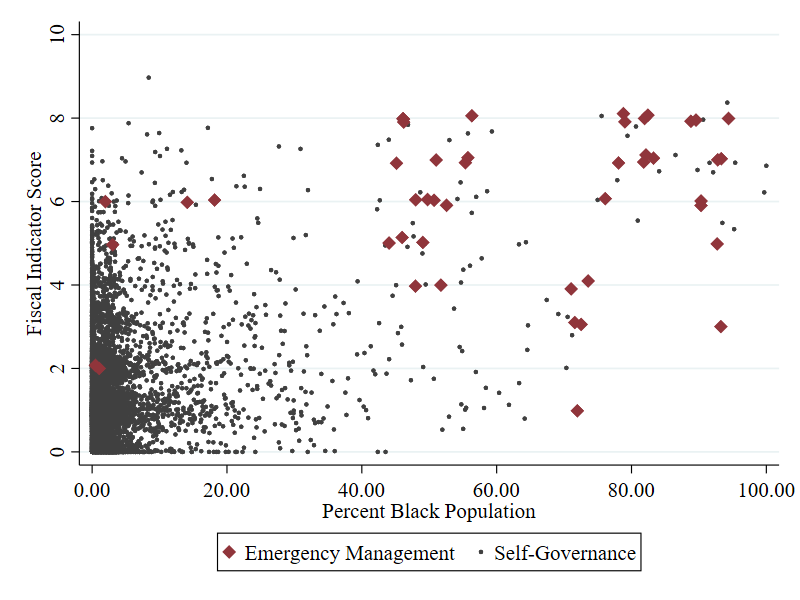Forthcoming in Issues in Race and Society: An Interdisciplinary Global Journal
| Filename | Source | Explanation |
|---|---|---|
| FIS RACE EM MAIN.xlsx | Authors qualitative research and Munetrix | Contains all cases of emergency management in Michigan from 2007-2013 and "Fiscal Indicator Scores" |
| DEC_00_SF3_DP3_with_ann.xlsx | Decennial US Census | Michigan population by Census track 060 for 2000 and 2010 |
| ACS_10_5YR_DP03_with_ann.xlsx | American Community Survey | Values for 2006-2013, used for interpolating race-percentages by census unit in interim years |
| em_rep.dta | Stata file with main analysis data | Worked up using the files 01_prep_FIS.do and 02_prep_ACS.do |
Work done in Stata and Mplus.
Replicators can start with the file 01_Descriptives.do to load the data and create the descriptive tables and figures in Stata.
The anaysis was done in Mplus, all output files are available in the folder /results/SEM and these results have been hand transferred into Excel in the document results/tbl3to5.xlsx.
The usage of emergency management by United States’ state-level governments to resolve troubled municipal finances increased dramaticallyover the past three decades. Layoffs, school closings, pension renegotiations, and sale of public assets are the product of such policies, and these policies unevenly affect black residents. Recent legal decisions argue this is an innocent byproduct of black concentration in fiscally distressed cities. Thus, targeted emergency intervention is colorblind in its application, and any race-bias is mere statistical discrimination among fiscally-challenged areas. We investigate this assertion, asking if raciallyinequitable outcomes signal differential impact on, or differential treatmentof black people. We investigate Michigan, the site of the country’s most intensive emergency management deployments. Using all politically incorporated units in Michigan, 2007-2013, we develop a counterfactual test using the state’s own fiscal distress scale and adjusting for percentage black and median household income of each unit. We find a net effect of the percentage of black residents on the likelihood of emergency management after adjusting for fiscal distress. If correctly specified, our model gives evidence that racial bias was a factor in the application of emergency management –that units in Michigan with similar fiscal distress levels were more likely to get emergencymanagement if they had higher black populations, all else equal. We cannot identify the specific micro-mechanisms at play, meaning we cannot conclude if any actors in the process had race-biased intentions, and we discuss the meaning of our findings in light of this.
We demonstrate statistically that the percent black population of a given local unit (city, town, school district) remain a significant predictor of emergency management after adjusting for relative need of managmeent measured by the degree of fiscal distress of that unit.
A visualization of our data and highlighted cases of emergency management

